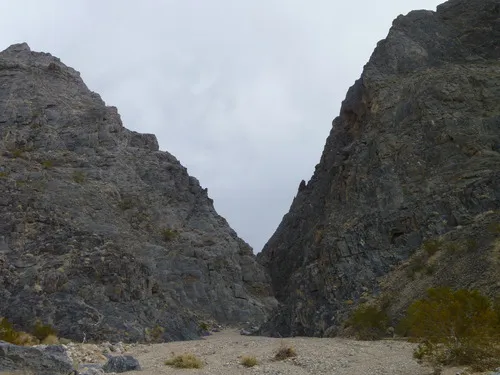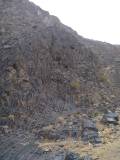
Corridor Canyon – Death Valley National Park
Hike down a canyon with fossils, narrows, and slippery dryfalls to a very straight, sheer-faced canyon deep in the Last Chance Range.
| Total Distance: 7.8 miles out & back with spur | Elevation Gain: 1,980ft. (3,860ft. to 2,880ft.) |
| Difficulty: Strenuous | 5-10 Mile Difficulty: Strenuous |
| View Rating: 3.0 out of 5.0 stars | Author’s Rating: 4.0 out of 5.0 stars |
| Visitor Rating: (Click to rate) [Total: 0 Average: 0] | Visitor Difficulty Rating: (Click to rate) [Total: 0 Average: 0] |
| Pets: No | Horses: Yes |
| Best Seasons: November-April | Special Permits: None |
| Water Availability: None | Overnight Options: Dispersed camping is permitted at least a mile from the Racetrack Road (aka not at the trailhead) |
| Trailhead Amenities: None | Crowd Factor: Solitude |
| Trailhead Access: 1.9 or 2.0 | |
| Uses: | Trail Surface: |
| Features: | Hazards: |
Mile-by-Mile: Corridor Canyon
0.0 Ubehebe Lead Mine Parking Area (3,861ft.). You’ll be walking downcanyon for much of the hike. Walk down the canyon (west) past the old mining area with quite a bit of historical remains. Walk around at your own risk and try not to disturb/breathe the dust any more than necessary. Old mine shafts pierce the area, along with many old mine implements/buildings and an old tramway. Before the first bend in the canyon, the route enters the Death Valley Wilderness Area. The canyon in this first area is pretty but not terribly narrow. Also, keep your eyes open for fossils in the rocks. (36.749246°, -117.585270°)
0.9 First Major Side-wash on right (north) (3,622ft.). Look back at this junction to make sure you remember to take the correct wash (the southerly one) on the way back. (36.753389, -117.592630)
1.5 Enter First Narrows (3,449ft.). Enjoy the narrow canyon; near the end, you may find some rock art. (36.755156, -117.600835)
1.6 End of First Narrows; enter wide wash (3,391ft.). Look back at this junction to make sure you remember to take the correct (much smaller!) wash on your return. Turn left to walk down the wide wash. There are many fossils in this area, so keep your eyes open. A few small dryfalls pose fun slides/minor obstacles. Enjoy a short slot section about mile 2.3. (36.754687, -117.602334)
2.8 Enter Third Narrows (3,077ft.). Continue downstream to a rather sketchy-looking dryfall. It appears to be very slippery and about 12ft. high. It can be descended (and re-ascended) with some careful climbing, but a rope is helpful. (36.749418, -117.614989)
3.0 Enter Corridor Canyon (3,064ft.). This is one of the easier junctions to find on the way back up, but you’ll still want to memorize the junction. To see the entire corridor, turn right to go upstream. (36.748758, -117.616916)
3.3 Dryfall (3,093ft.). This is the head of the “Corridor,” though it may be possible to explore further upstream by climbing up the rockfall/dryfall on the left side. Retrace your steps back down to the slot entrance and then continue downstream. The Corridor is not very narrow, but it’s fascinating in terms of the almost sheer walls on either side and how straight it cuts through the Last Chance Range. (36.752730, -117.618148)
4.2 End of the Corridor (2,890ft.). The canyon doubles back on itself at this point. While most people opt to turn around here, there’s no reason you can’t continue to explore downstream if you want to – at least to the next dryfall! (36.739708, -117.615712)
History & More
Corridor Canyon is named for the nearly mile-long, almost completely straight “corridor” through the hills. While it’s not especially narrow, there are some cool slots to explore en route to Corridor Canyon.
There are several slick dryfalls along the route, but most are short enough that they don’t pose much in the way of challenge. The 12ft. dryfall is the one real obstacle. If you’re not comfortable with it, the hike is still worth it to see the narrows. Some hikers like to bring along a rope to help each other down (and up!) the dryfall.
Corridor Canyon eventually empties out into Saline Valley. I’ve never heard of anyone doing a shuttle trip between the Ubehebe Lead Mine and the Saline Valley Road, but it would almost certainly be possible if you can negotiate the lower dryfalls.
I hear that the dryfalls below the end of the Corridor are very slick. One (about mile 5) can be bypassed via a steep Class 3 or 4 crack in the rocks just north of the dryfall. Another dryfall at about mile 6 may be able to be bypassed via the next side drainage. At any rate, the lower part of Corridor Canyon is definitely an adventure that is easier to descend than climb back up!
Download Trail Map
Coming soon!
Driving Directions
Take the Racetrack Road from the Ubehebe Crater Road 21.7 miles from the crater. Turn right onto the unmarked dirt road heading west – otherwise known as the Ubehebe Lead Mine Road. Drive 0.75 miles to the end of the road and park near the ruins.
Camping in a canyon is discouraged due to the danger of flash floods.
Remember, it may be easier to climb up dryfalls than down them (or vice versa). Be sure you can climb in the other direction before climbing up or down a dryfall.
Camping is not allowed within one mile of a paved road, developed area, or dirt road that is closed to camping.
Camping is not permitted within 100 feet of a flowing stream, spring, or other natural body of open water.
No camping is permitted on the floor of Death Valley, within one mile of Darwin Falls and Greenwater Canyon, on the active/shifting sand dunes, and certain other canyons and backcountry areas.
Camping is also prohibited within one mile of the Ubehebe Lead Mine, Leadfield Mines, Keane Wonder Mill, and Skidoo Mill.
Camping is limited to 30 days per calendar year within the park.
Fires are permitted in NPS-provided fire grates or grills ONLY.
Leave No Trace Principles are enforced
Drones and model aircrafts are prohibited
Camping is permitted only in designated sites or in areas open to dispersed backcountry camping
All park rules and regulations
12 Month Pass: $55/Death Valley Annual Pass (valid at Death Valley National Park). $80/America the Beautiful Annual Pass (valid at all national park and federal fee areas). $20/Annual Senior Pass (62 years or older US citizens; valid at all national park and federal fee areas). Free/4th Grade Pass (Valid Sept. 1-August 31 of the child’s 4th Grade school year). Free/Military Pass (valid for all active military personel and their dependents with a CAC Card or DD Form 1173).
Lifetime Pass: $80/Lifetime Senior Pass (62 years or older US citizens; valid at all national park and federal fee areas). Free/Access Pass (available to all US citizens with perminent disabilities). Free/Access for Veterans and Gold Star Families Pass (valid for all military and veterans with a CAC card, Veteran HJealth Identification Card, Veteran ID Card, or veteran’s designation on state-issued drivers license or identification card.)




















